
HPU2. Nat. Sci. Tech. Vol 03, issue 02 (2024), 59-69.
HPU2 Journal of Sciences:
Natural Sciences and Technology
Journal homepage: https://sj.hpu2.edu.vn
Article type: Research article
Received date: 27-4-2024 ; Revised date: 02-7-2024 ; Accepted date: 06-7-2024
This is licensed under the CC BY-NC 4.0
59
A convergence enhancement approach
for tomographic reconstruction in ultrasonic tomography
Quang-Huy Tran
a
*
, Minh-Duc Dao
a
, Manh-Quang Vu
a
, The-Lam Nguyen
a
,
Thi-Theu Luong
b
a
Hanoi Pedagogical University 2, Vinh Phuc, Vietnam
b
Hoa Binh University, Hanoi, Vietnam
Abstract
Ultrasound tomography is a non-invasive imaging technique that seeks to determine the internal
distribution of acoustic properties within the body by analyzing measured ultrasound data. Based on
the distorted Born iterative method (DBIM), this work suggests employing resolution-jumping and
beamforming techniques for tomographic ultrasound imaging. The beamforming technique leverages
multiple transmitting elements from the ultrasound probe, operating concurrently, to generate a
focused and narrow beam. This targeted approach helps in reducing noise, thus enhancing the quality
of the collected data. Meanwhile, resolution-jumping optimizes the imaging process by adjusting the
resolution dynamically, thereby improving both the quality and speed of the reconstruction. The
benefits of the proposed method are evident in the results of numerical simulations, which demonstrate
a substantial improvement in the quality of image recovery. These simulations also highlight a
significant reduction in the total runtime required for imaging, showcasing the efficiency of the
approach. By combining these advanced methods, the work offers a promising pathway toward more
accurate and faster tomographic ultrasound imaging, which could lead to better diagnostic capabilities
in medical applications.
Keywords: Inverse scattering, beamforming, interpolation, ultrasound tomography, distorted Born
iterative method
1. Introduction
An imaging method called ultrasound tomography uses acoustic fields to provide images in
heterogeneous media. It involves the reconstruction of cross-sections of the internal structures of the
*
Corresponding author, E-mail: tranquanghuy@hpu2.edu.vn
https://doi.org/10.56764/hpu2.jos.2024.3.2.59-69

HPU2. Nat. Sci. Tech. 2024, 3(2), 59-69
https://sj.hpu2.edu.vn 60
body by linearizing the non-linear wave equation and applying the Born or Rytov approximation. It is
particularly useful for imaging soft tissues and is commonly employed in various medical applications,
including breast imaging, liver imaging, and vascular imaging. Diffraction tomography is a specific
type of ultrasound tomography that utilizes the generalized Fourier slice theorem for image
reconstruction 0. Ultrasonic computed tomography (UCT) is another approach that numerically solves
the inverse scattering issue associated with the forward scattering issue in inhomogeneous media.
Various approximations can be used depending on the level of inhomogeneity, such as the straight ray
approximation or high-order approximations [2]. Acoustic travel-time tomography is a remote sensing
technique that measures temperature and flow fields by analyzing the dependence of sound speed on
temperature and wind speed. It can be used to reconstruct three-dimensional distributions of
temperature and flow fields without the need for sensors 0.
Research on ultrasound tomography utilizes various methodologies. One common approach is the
distorted Born iterative method (DBIM), which uses inverse scattering techniques to detect small
targets by analyzing sound contrast or attenuation 0–0. Another methodology is the use of the
truncated total least squares (TTLS) and regularized total least squares (RTLS-Newton) algorithms to
solve the ill-posed linear system of inverse scatter equations 0. Additionally, signal processing
methods such as wavelet-based or energy-based methods are employed to determine the time of flight
(TOF) in ultrasound tomography 0. The acoustic wave equation in the time domain is tackled using
the finite element method, followed by the comparison of numerical results with experimental data 0.
Additionally, a wavelet transform-based adaptive filtering algorithm is introduced to enhance filtering
and denoising efficacy in tomography systems 0.
Beamforming is a technique widely used in ultrasound imaging, including ultrasound
tomography. It involves combining signals from multiple transducers to enhance the quality and
resolution of the resulting image 0. Beamforming in ultrasound tomography offers numerous
advantages, including improved resolution, enhanced image quality, increased penetration depth,
customizable imaging parameters, real-time imaging capabilities, and optimal SNR. These features
collectively contribute to the effectiveness and versatility of ultrasound tomography in medical
imaging applications. Nearest neighbor interpolation is a simple and computationally efficient method
used in image processing, including ultrasound tomography. While it may not be the most
sophisticated interpolation technique, it does have some advantages in specific contexts. Nevertheless,
it's essential to emphasize that the choice of interpolation method depends on the specific requirements
and characteristics of the imaging application. Nearest neighbor interpolation is computationally less
intensive compared to more complex interpolation methods 0. In real-time or near-real-time imaging
applications, where speed is critical, the simplicity of nearest neighbor interpolation can be
advantageous. Therefore, this study proposes the use of resolution-jumping and beamforming
techniques for tomographic image reconstruction. The beamforming approach utilizes multiple probe
transmitting elements concurrently to create a focused beam, thereby minimizing noise. Concurrently,
resolution-jumping is used to boost the quality and speed of the reconstruction process. The outcomes
from numerical simulations indicate a significant enhancement in image recovery quality, as well as a
marked decrease in overall imaging time.

HPU2. Nat. Sci. Tech. 2024, 3(2), 59-69
https://sj.hpu2.edu.vn 61
2. Methodology
2.1. Distorted Born iterative method
Figure 1. The ultrasonography imaging system's transducer arrangement.
For collecting scattered data, we establish a transducer setup, as shown in Figure 1, assuming the
presence of Nr receivers and Nt transmitters. These transmitters Nt are strategically positioned at
various angles around the object to capture comprehensive information about it. The ultrasonic signal
reception and transmission follow this procedure: Initially, the first three transmitters' ultrasonic waves
are simultaneously captured by all receivers (Nr), while the remaining transmitters remain inactive.
This assembly of measurements (i.e., 1×Nr measurements) is employed to determine the original
transmitter positions. Subsequently, the process is repeated with the next set of three transmitters, with
all receivers detecting scattering signals at the second set of transmitter locations. This results in a
subsequent set of measurements, totaling 2×Nr measurements. The identical procedure is then applied
to the remaining transmitters. Once the measurement process is completed, we acquire Nt/3 sets of
collected values, totaling Nt×Nr/3 measurements. In order to achieve a holistic perspective of the
object from multiple angles, the results obtained from these Nt/3 sets are integrated.
The integral equation can be used to describe the propagation of waves in an inhomogeneous
medium 0, 0:
σ
(
r
)
=
σ
(
r
)
+
d
r
θ
(
r
)
p
(
r
)
G
(
r
,
r
)
(1)
where 𝛔(𝐫) denotes the acoustic pressure, while 𝛔𝐢𝐧𝐜(𝐫) represents the incident field. 𝐆𝟎(𝐫,𝐫) is
the Green's function associated with a background environment characterized by wave number 𝐤𝟎.
The function 𝛉(𝐫) contains details about the acoustic properties of the imaging target. When
considering constant density and negligible attenuation, 𝛉=𝐤𝟐(𝐫)−𝐤𝟎
𝟐. Using the method of
moments (MoM), Equation (1) can undergo discretization, enabling its representation in matrix form
for both the pressure field within the computational domain, denoted as 𝛔‾, and the scattered field
outside the computational domain, represented as 𝛔‾sc, as follows:

HPU2. Nat. Sci. Tech. 2024, 3(2), 59-69
https://sj.hpu2.edu.vn 62
σ
‾
=
(
I
‾
−
C
‾
⋅
𝒟
(
θ
)
)
⋅
σ
(2)
σ
‾
sc
=
B
‾
⋅
𝒟
(
θ
)
⋅
σ
‾
(3)
here 𝐁‾ is a matrix containing Green's coefficients that describe the influence of each pixel on the
receivers, while 𝐂‾ is a matrix encompassing Green's coefficients across all pixels. Additionally, 𝓓 is
an operator that converts a vector into a diagonalized matrix. Discretizing Equation (1) applied to both
2-D and 3-D scenarios was carried out using sinc basis and delta testing functions 0.
An iterative algorithm is utilized to reconstruct the object function from the scattered field data.
The process begins with an initial trial function 𝛉
(𝟎), and the corresponding scattered field is
calculated based on this initial guess. The object function is then refined iteratively according to the
update equation as 𝛉
(𝐧𝟏)=𝛉
(𝐧)+𝚫𝛉
(𝐧), where 𝚫𝛉
(𝐧) is the change in the object function for the nth
iteration. This change is determined by solving a regularized optimization problem, which aims to
minimize the difference between the measured and calculated scattered fields while incorporating
regularization terms to ensure stability and convergence:
Δ
θ
(
)
=
argmin
𝒪
∥
∥
Δ
σ
‾
sc
−
H
‾
(
)
⋅
Δ
θ
∥
∥
+
γ
∥
Δ
θ
∥
(4)
where the term 𝚫𝛔‾sc represents the discrepancy among the predicted and measured scattered
fields, while the regularization parameter 𝛄 controls the trade-off between data fidelity and model
stability. The Frechet derivative matrix 𝐇
‾(𝐧) is structured as follows 0:
H
‾
(
)
=
B
‾
⋅
I
‾
−
𝒟
θ
(
)
⋅
C
‾
⋅
𝒟
(
σ
‾
)
(5)
The iterative process continues until the relative residual error (RRE) meets the desired
termination tolerance. The RRE is calculated as RRE =
∥
∥
𝚫𝛔‾sc
∥
∥
𝟐/
∥
∥
𝛔‾sc
∥
∥
𝟐, where
∥
∥
𝚫𝛔‾sc
∥
∥
𝟐 denotes the
2-norm of the variance between the predicted and measured scattered fields. The regularization
parameter 𝛄 is determined based on the method outlined in 0:
γ
=
0
.
5
σ
max
10
,
10
(6)
where the square of the dominant singular value of 𝐇
‾(𝐧), denoted as 𝛔𝟎
𝟐, is computed using the
power iteration method in conjunction with Rayleigh quotient estimation. This approach provides an
efficient way to estimate the largest singular value and its corresponding square. The quality of the
reconstructions is assessed by calculating the mean average error (MAE). The MAE is calculated
based on the difference between the reconstructed speed of sound contrasts 𝚫𝐜ˆ and the ideal speed of
sound contrasts 𝚫𝐜. This metric quantifies the average deviation between the reconstructed and ideal
values, providing a measure of the accuracy and effectiveness of the reconstruction process as follows:
MAE
=
∥
Δ
c
ˆ
−
Δ
c
∥
∥
Δ
c
∥
(7)
The single-frequency DBIM may experience divergence issues when the excess phase
magnitude
Δ
ϕ
accumulates from the acoustic wave as it travels through the scatterer approaches
π
0.
In the case of a homogeneous sphere,
Δ
ϕ
shown in Eq. (8) can be estimated based on factors such as

HPU2. Nat. Sci. Tech. 2024, 3(2), 59-69
https://sj.hpu2.edu.vn 63
the size of the sphere, the speed of sound in the sphere relative to the surrounding medium, and the
frequency of the acoustic wave. This estimation helps determine whether the phase shift is within a
tolerable range for the method to remain stable and accurate.
Δ
ϕ
=
2
k
a
(
c
−
1
)
(8)
where the relative speed of sound, denoted as 𝐜𝐫=𝐜/𝐜𝟎, measures the speed of sound in the
scatterer 𝐜 relative to the speed of sound in the surrounding medium 𝐜𝟎. For a homogeneous sphere
with radius 𝐚, the excess phase |𝚫𝛟| accumulated from the acoustic wave while passing through the
sphere can be estimated using these parameters. When applying the linearized first-order Born
approximation, the quality of the reconstructions can degrade even when the absolute value of 𝚫𝛟 is
smaller than 𝛑 0. As a result, any scattering object for which |𝚫𝛟|>𝛑 is considered to possess a
significant acoustic contrast and may pose challenges for accurate reconstruction due to the higher
likelihood of divergence.
Nearest neighbor interpolation is the simplest and most commonly used interpolation method. It
is computationally less intensive compared to more sophisticated interpolation methods like bilinear or
cubic interpolation. The algorithm is easy to implement and requires minimal computational resources.
The new pixel takes the value of the original pixel closest to it and does not consider other values in all
neighboring points. The distance between two points is often measured as the Euclidean distance or
Minkowski distance with k = 2. Kernel function of the nearest neighbor interpolation method 0 is
shown as:
h
(
x
)
=
1
|
x
|
≤
1
2
0
1
2
≤
|
x
|
(9)
where, x is the distance between the interpolation point and the grid point. Suppose that we have
a pixel (u,v) with four neighbours (i, j), (i, j + 1), (i + 1, j) and (i + 1, j + 1), and values f(i, j), f(i, j +
1), f(i + 1, j), f(i + 1, j + 1) as shown in Figure 2. The distance between (u,v) and (i, j), (i, j + 1), (i +
1, j), (i + 1, j + 1) will be calculated, the value at (u, v) will be assigned the value of the point closest
to it.
Figure 2. Illustration of calculating new pixels (u,v) using the nearest neighbor interpolation method.
The image restoration procedure comprises two distinct phases: In the initial stage, the object is
reconstructed with low resolution (N1×N1) during the initial iterations employing the beamformed
approach. This initial stage employs lower resolution to facilitate rapid convergence. Subsequently, in

![Bài giảng Tự động hóa trong quản lý xây dựng [Mới nhất]](https://cdn.tailieu.vn/images/document/thumbnail/2025/20250715/maiah9403@gmail.com/135x160/74371752631017.jpg)
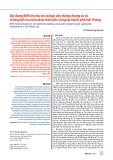
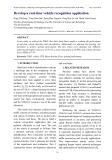
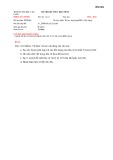
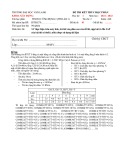












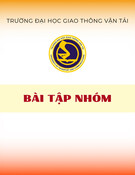

![Bài giảng Quản lý vận hành và bảo trì công trình xây dựng [chuẩn nhất]](https://cdn.tailieu.vn/images/document/thumbnail/2025/20251006/agonars97/135x160/30881759736164.jpg)





